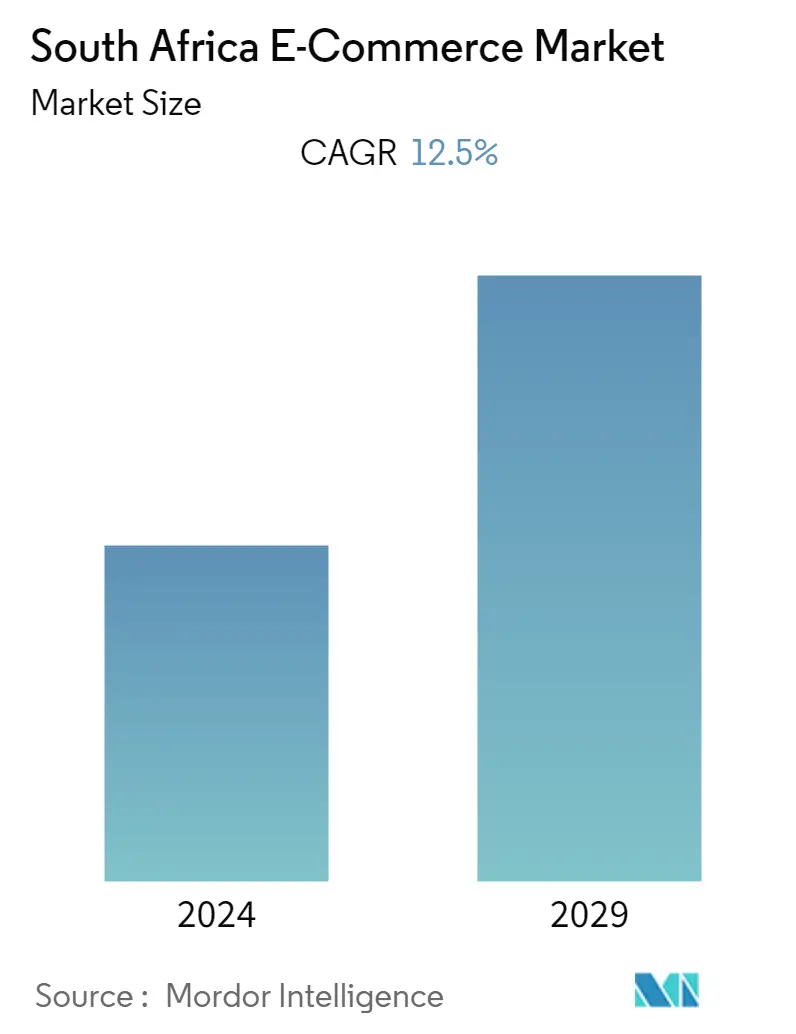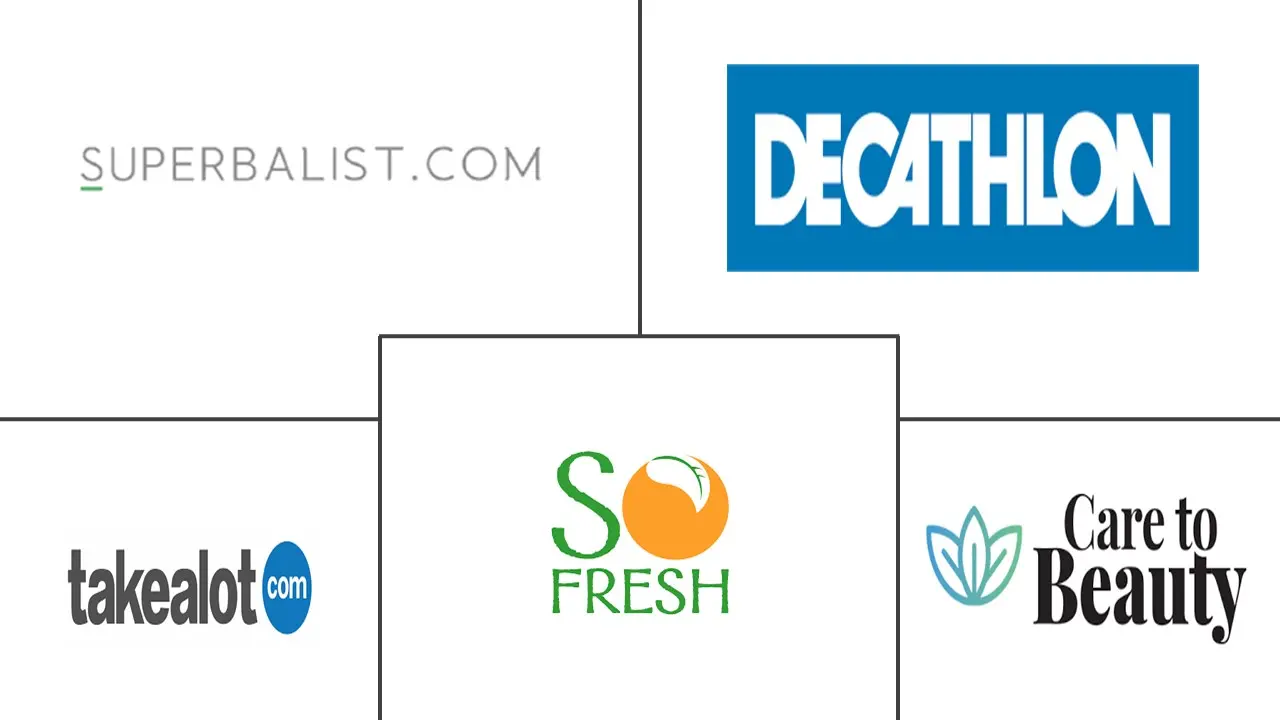Market Size of South Africa E-Commerce Industry

| Study Period | 2018 - 2028 |
| Base Year For Estimation | 2021 |
| Forecast Data Period | 2024 - 2028 |
| Historical Data Period | 2018 - 2020 |
| CAGR | 12.50 % |
| Market Concentration | Medium |
Major Players
*Disclaimer: Major Players sorted in no particular order |
Need a report that reflects how COVID-19 has impacted this market and its growth?
South Africa E-Commerce Market Analysis
E-commerce is growing at an unprecedented rate in South Africa. According to Business Insider, this surge was mostly influenced by restrictions placed on traditional retail outlets, which resulted in a 30% fall in in-store shopping. While several sectors of the economy were hamstrung by various degrees of lockdown in 2020, internet retailers saw a surge in sales as South Africans opted for home delivery over shopping malls and stores. Further, the market is expected to grow at a CAGR of 12.5% during the forecast period (2022 - 2027).
- The proliferation of smart devices and the expansion of internet connectivity has created an e-commerce platform. Apart from that, increasing integration of e-commerce platforms with various advanced technologies such as cloud computing, artificial intelligence, and predictive analytics is also driving the growth of the South African e-commerce market.
- Based on the payment mode, various digital payments such as bank transfers, cards, cash on delivery (COD), direct delivery, electronic wallet, etc., are becoming more popular in South African countries.
- Consumers also use electronic wallet services and EFT for online payments. Moreover, with an e-wallet, customers can receive, store, and use the money on their mobile phones with or without internet access. South Africans are familiar with online shopping, experience the convenience of online shopping, and may shop online more often in the future.
- Smartphone penetration is also playing a very important role in shopping trends. This is due to the fact that convenience is another major reason why people choose to shop online. They have access to a wide range of products to compare reviews and can instantly satisfy their purchase with the click of a button. With flexible alternatives to traditional courier services, South Africa can continue to grow e-commerce by ensuring that deliveries are not missed.
- E-commerce is one of the few sectors in COVID-19 where consumer interaction has increased. In South Africa, the lockdowns in 2020 have made online shopping a trend. These lockdowns or home orders highlight the value of e-commerce as consumers are forced to stay home and find other digital shopping options in South Africa.
South Africa E-Commerce Industry Segmentation
E-commerce refers to any form of commerce that takes place online. This is defined as buying and selling goods over the internet on any device. E-commerce is typically categorized into two different models, B2B and B2C, based on the type of participants involved in the transaction. The market studied includes segmentation based on the categories based on different product types, and also the market studied briefs about the COVID-19 impact on the country and current ongoing e-commerce trends as well.
| By B2C ecommerce | ||||||||
| Market size (GMV) for the period of 2017-2027 | ||||||||
|
| By B2B ecommerce | |
| Market size for the period of 2017-2027 |
South Africa E-Commerce Market Size Summary
The e-commerce sector in South Africa is experiencing unprecedented growth due to restrictions on traditional retail outlets and the surge in online shopping. The market is predicted to expand further over the forecast period. This growth has been driven by the proliferation of smart devices, the expansion of internet connectivity, and the integration of e-commerce platforms with advanced technologies such as cloud computing and artificial intelligence. Digital payments, including bank transfers, cards, cash on delivery, direct delivery, and electronic wallets, have become increasingly popular. The convenience of online shopping and the wide range of products available have also contributed to the growth of the e-commerce market in South Africa. The fashion industry in South Africa has seen significant growth due to the progression of digitization. Major domestic and international clothing retailers have an online presence and are investing heavily in e-commerce platforms to improve user experience. The increase in smartphone penetration has also boosted the market for online shopping. South African retailers are learning from companies that have successfully adapted to hybrid models, investing in online experiences to deliver a better customer experience. The country is witnessing a rise in supply with growing internet penetration and a mobile-first population, setting the stage for a fashion e-commerce boom. Furthermore, the use of digital tools can help African fashion brands pursue global success.
Explore MoreSouth Africa E-Commerce Market Size - Table of Contents
-
1. MARKET INSIGHTS
-
1.1 Market Overview
-
1.2 Industry Attractiveness-Porter's Five Force Analysis
-
1.2.1 Bargaining Power of Suppliers
-
1.2.2 Bargaining Power of Buyers/Consumers
-
1.2.3 Threat of New Entrants
-
1.2.4 Threat of Substitute Products
-
1.2.5 Intensity of Competitive Rivalry
-
-
1.3 Key market trends and share of e-commerce of total Retail sector
-
1.4 Impact of COVID-19 on the e-commerce sales
-
-
2. Market Segmentation
-
2.1 By B2C ecommerce
-
2.1.1 Market size (GMV) for the period of 2017-2027
-
2.1.2 Market Segmentation - by Application
-
2.1.2.1 Beauty and Personal Care
-
2.1.2.2 Consumer Electronics
-
2.1.2.3 Fashion and Apparel
-
2.1.2.4 Food and Beverage
-
2.1.2.5 Furniture and Home
-
2.1.2.6 Others (Toys, DIY, Media, etc.)
-
-
-
2.2 By B2B ecommerce
-
2.2.1 Market size for the period of 2017-2027
-
-
South Africa E-Commerce Market Size FAQs
What is the current South Africa E-Commerce Market size?
The South Africa E-Commerce Market is projected to register a CAGR of 12.5% during the forecast period (2023-2028).
Who are the key players in South Africa E-Commerce Market?
Superbalist.com, Takealot Online (Pty) Ltd., Decathlon, Sofresh and Care to beauty are the major companies operating in the South Africa E-Commerce Market.
